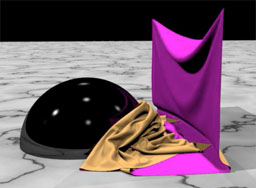![Monsters Inc. [Pixar]](images/pixar_8999674.jpg)
![Yarn-level cloth simulation
[Yuksel et al. 2012]](images/thumb_StitchMeshes_teacozy.jpg)
![[Langlois and
James 2016]](images/thumb_Langlois2016.png)

| Stanford
University, 2019 Winter CS 348C: Computer Graphics: Animation and Simulation Instructor: Prof. Doug James |
![Monsters Inc. [Pixar]](images/pixar_8999674.jpg) |
![Yarn-level cloth simulation
[Yuksel et al. 2012]](images/thumb_StitchMeshes_teacozy.jpg) |
![[Langlois and
James 2016]](images/thumb_Langlois2016.png) |
 |
| Description: Core mathematics and methods for computer animation and motion simulation. Traditional animation techniques. Physics-based simulation methods for modeling shape and motion: particle systems, constraints, rigid bodies, deformable models, collisions and contact, fluids, and fracture. Animating natural phenomena. Methods for animating virtual characters and crowds. Additional topics selected from data-driven animation methods, realism and perception, animation systems, motion control, real-time and interactive methods, and multi-sensory feedback. |
| Location |
|
Wallenberg Hall
(160-124) |
| Time |
TuTh 1:30PM - 2:50PM (01/07/2019 - 03/15/2019) | |
| Office Hours
(Prof) |
Wed 4:00-6:00 PM (Gates 362), or by
appointment |
|
| TA |
Paul
Liu (CS PhD student) Office hours:
|
|
| Prerequisites |
Recommended:
CS148 and/or CS205A. Prerequisite: linear algebra. (or
permission of instructor) |
|
| Textbook |
None;
lecture notes and research papers assigned as readings
will be posted here. |
|
| Communication |
Piazza: https://piazza.com/stanford/winter2019/cs348c | |
| Calendar |
Google
Calendar Link |
|
| Requirements |
Students
are expected to attend lectures, participate in class
discussions and working sessions, and read the
supplemental materials. |
|
| Assignments |
There
will be programming assignments, and a final project based
on a student-selected topic. |
|
| Late
Policy |
We
allow 3 late days, with 10%/day deduction thereafter. |
|
| Exams |
None |
|
| ExploreCourses |
Link |
ASSIGNMENTS
|
Student
Results (2019 Winter)
|
| SCHEDULE: |
| DATE |
TOPIC |
SUPPLEMENTAL MATERIALS |
| TuJan08 |
Introduction |
Slides:
Homework Activities:
|
| Due WeJan16 |
Homework #1: Hello
Houdini |
Assignment Link Video Highlights |
| ThJan10 |
Introduction to Houdini |
Material: |
| TuJan15 |
Procedural
Modeling![Procedurally modeled "mineral"
[David Ferreira]](images/thumb_proceduralMineral_DavidFerreira.png) |
Material: |
| Due WeJan23 |
Homework #2:
Procedural Modeling![Procedurally modeling in "Planet
Alpha" [Adrian Lazar]](images/thumb_procedural_projectAlpha.png) |
Assignment Link Image Credit: "Planet Alpha," Adrian Lazar |
| ThJan17 |
Particle
Systems |
Weekly: "Hello Houdini" Whiteboard notes on Piazza (Resources) Material:
References:
|
| TuJan22 ThJan24 TuJan29 |
Robust Collision Processing |
Weekly (Thurs24):
Procedural Modeling Whiteboard notes on Piazza (Resources) Material:
|
| Due WeFeb06 |
Homework #3: Robust Collision Processing (a.k.a. "The Spaghetti Factory") |
Starter Code is
available on Canvas. Submit a png image of your best spaghetti factory run here. |
| TuJan29 ThJan31 |
Constrained Dynamics |
Material:
|
| Taking Derivatives: From Tensor Calculus, to Symbolic and Automatic Differentiation  |
Material: Differentiating
the following quantities with respect to particle
position vectors, p_i:
|
|
| TuFeb05 |
Rigid-Body Motion![Rigid Body Dynamics (from [Baraff
2001])](images/thumb_RBD.png) |
References:
|
| Due WeFeb13 |
Homework #4: Character Animation FX |
Submit your video artifact for weeklies using this Dropbox File Request. Full artifact/code/hipnc submission on Canvas. |
| Due WeFeb20 |
Final Project Proposal |
|
| ThFeb07 TuFeb12 |
Particle-based Fluids |
Material:
|
| TuFeb12 ThFeb14 TuFeb19 ThFeb21 |
Fluid Animation![From [Stam 1999]](images/thumb_stableFluids.png) |
Topics:
|
| Due WeFeb27 |
Homework #5: Fluid Animation |
Fluid Animation [2
weeks, 20%, Student choice between:
Submit your video artifact for weeklies
using this Dropbox
File Request |
| TuFeb26 |
Material
Point Method (MPM), and Snow
Simulation![[Stomakhin et al. 2013]](http://alexey.stomakhin.com/research/snowman.jpg) |
Discussed:
Material:
|
| ThFeb28 |
Rigid-body Contact: Impulse- and Contraint-based Methods: ![From [Erleben]](images/thumb_erleben.png) ![From [Kaufman et al. 2008]](images/card.png) |
Material:
|
| TuMar05 |
Lightning, Ice
Growth, and Diffusion Limited Aggregation (DLA) |
Material:
|
| ThMar07 |
Animation Sound |
Material:
|
| TuMar12 |
Guest Speaker: Ted Kim (Pixar) |
Guest Speaker:Theodore KimTalk Information: Research and Collaboration in Incredibles 2 and Bao Abstract: In this talk, I will describe two successful collaborations that took place between research, development, and production during the making of the motion picture Incredibles 2, as well as the short film that preceded it, Bao. For Incredibles 2, we developed a robust new algorithm for skin simulation that was used during a key fight scene between the baby Jak-Jak and a raccoon. For Bao, our colleagues in production leveraged a robust new volume simulation technique that research had recently developed in order to deal with challenging cloth simulation scenarios.
|
| ThMar14 |
Project Presentations |
| Related prior course offerings: Other material: |
| DATE | TOPIC | SUPPLEMENTAL MATERIALS |
| Prog. Assignment #1: Position-Based Fluids |
|
|
| Implicit Integration & Cloth Simulation ![[Baraff and Witkin 1998]](images/thumb_BW98.jpg) |
Material:
|
|
| |
Application of Rigid-Body Motion: Shape Matching Methods ![Pengchinko! [Rivers and James 2007]](images/thumb_fastlsmPenguins.jpg) |
Discussed:
|
| Position-Based Simulation
Methods
and other relaxation-based dynamics ![From Nucleus [Stam
2009]](images/thumb_pub_nucleus.jpg) |
References:
|
|
| Prog. Assignment #2: Position-Based Dynamics ![From [Muller et al. 2006]](images/thumb_posBasedDyn.jpg) |
|
|
Fracture Animation![Fracture sound -- From [Chadwick et al. 2012]](images/thumb_fasterPAN_SCA2012.jpg) |
Material:
|
|
Guest Speaker![From "Power
Particles" [de Goes et al. 2015]](images/thumb_pp.jpg) |
Guest Speaker: Material:
Power Particles: An incompressible
fluid solver based on power diagrams
|
|
| Assignment #2:
Constrained Dynamics |
||
Final-Project Working Class |
|
|
Noise
& Turbulence Modeling![from [Kim et al. 2008]](http://www.cs.cornell.edu/%7Edjames/research/pics/Kim08.png) |
Materials:
|